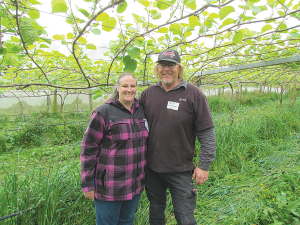Zespri global sales top $5 billion for 2024–25 season amid strong demand
Zespri says global sales for the 2024-25 season topped $5 billion on the back of strong demand and market returns.
 South Auckland kiwifruit growers Brett and Fenella Wheeler took out the supreme title in the Auckland Ballance Farm Environment Awards this year.
South Auckland kiwifruit growers Brett and Fenella Wheeler took out the supreme title in the Auckland Ballance Farm Environment Awards this year.
South Auckland kiwifruit grower, Brett Wheeler, jokes that some of the companion plants in his 13-hectare effective Glenbrook orchards are so large he has to take to them with a chainsaw.
But it's all part of improving soil health and biology, which has seen him and wife Fenella's BFG Kiwi take out the supreme title in the Auckland Ballance Farm Environment Awards this year.
At a field day at the end of September, Wheeler talked about changes on 8.3ha they bought in 2015. It was growing avocados, but they set about removing most of them to plant 2.6ha of Gold kiwifruit them more recently 2ha of Red.
While the Wheelers don't run an organic production system, they choose not to weed spray. No cultivation takes place after picking, which allows soil life to break down prunings left on the ground between the rows. Then after aeration oats are drilled which Brett says are the deepest rooting annuals, he could find from trials he's run over 10 years on their home orchard further west on the Manukau Harbour.
Tama ryegrass is also used with both crops singed by the application of Hi Cane he carries out himself. But these quickly bounce back and are allowed to seed so there'll be some regeneration for the next season.
Before pickers supplied by local packhouse, Punchbowl, arrive Brett uses a roller to knock the grass down for around a week while harvest is carried out.
They soil test once a year, with trials on their home orchard carried out over the last three years showing a big increase in soil organisms.
"There used to be no worms but now I can't count them, there's that many," Wheeler told Hort News.
They also regularly leaf test in order to adjust fertigation.
A Tailored Approach
Both of the Wheelers' orchards are fully mapped so a tailored approach can be taken to each plant's age, stage of growth and variety.
There are seven different sections to the orchards, with each having its own water meter and irrigation system controlled and monitored through a mobile app. Drippers have only been placed in every second row in the new orchard with water use able to be cut back because the ground cover means less sun getting to the soil so less evapotranspiration. From harvest to flowering humic and folic acid are applied as well as molasses, fish concentrate, seaweed and sea water.
This year, the Gold crop - in its third year - was picked early in the season and produced 13,500 trays/ha. This was well up on Punchbowl's average of 10,500. The Red part of the orchard produced its first crop of 5,000 trays. However, it was more affected by Cyclone Gabrielle with some 40-year-old Hayward rootstock which had been grafted over being wiped out.
"The water was knee deep for a week, so a lot of new drainage has gone in."
The orchard is all hail netted with flashing tape hung beneath it to keep any birds out. Landmarks are also placed above the canopy so pollinating bees can orient themselves more rapidly to get on with the job at hand.
To cut back on the pollen required they're in the process of building up their own orchard of male plants using the M36 and M43 varieties. Future plans also include removing more avocados and riparian planting along their 20-metre cliff face boundary.
Although not a dairy farmer Brett says he now wants to start replacing his herd - "some are getting a bit tired".
When American retail giant Cosco came to audit Open Country Dairy’s new butter plant at the Waharoa site and give the green light to supply their American stores, they allowed themselves a week for the exercise.
Fonterra chair Peter McBride says the divestment of Mainland Group is their last significant asset sale and signals the end of structural changes.
Thirty years ago, as a young sharemilker, former Waikato farmer Snow Chubb realised he was bucking a trend when he started planting trees to provide shade for his cows, but he knew the animals would appreciate what he was doing.
Virtual fencing and herding systems supplier, Halter is welcoming a decision by the Victorian Government to allow farmers in the state to use the technology.
DairyNZ’s latest Econ Tracker update shows most farms will still finish the season in a positive position, although the gap has narrowed compared with early season expectations.
New Zealand’s national lamb crop for the 2025–26 season is estimated at 19.66 million head, a lift of one percent (or 188,000 more lambs) on last season, according to Beef + Lamb New Zealand’s (B+LNZ) latest Lamb Crop report.

OPINION: Your old mate welcomes the proposed changes to local government but notes it drew responses that ranged from the reasonable…
OPINION: A press release from the oxygen thieves running the hot air symposium on climate change, known as COP30, grabbed your…